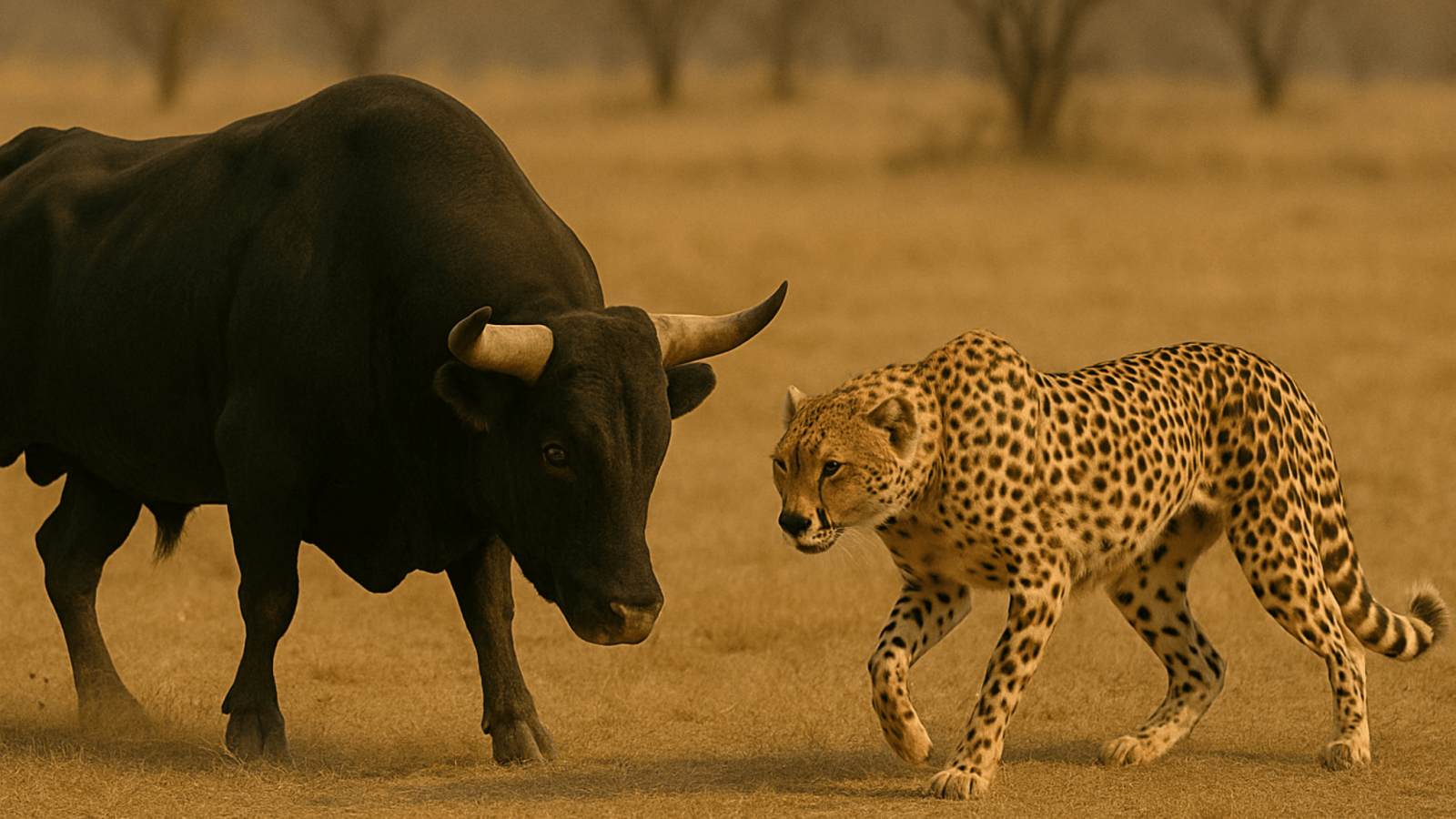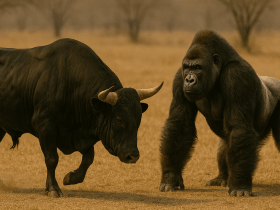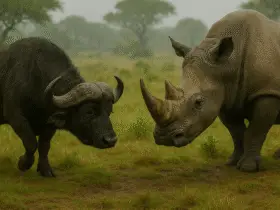A bull vs cheetah may sounds like that its not a worthy fight. But still it’s a fascinating clash between brute strength and explosive speed. The bull is a heavy, muscular animal known for its raw power, stamina, and ability to charge with serious force. The cheetah, the fastest land animal on Earth, relies on speed, agility, and precision rather than strength.
While they’re unlikely to meet in nature, imagining how these two very different animals would compare in a face-off opens up an exciting battle of muscle vs motion. Let’s break it down and see who might have the high chance of winning with the best features.
Let’s begin the ultimate comparison of bull vs cheetah!
1. Body Specifications
| Subtopic | Bull (Bos taurus) | Cheetah (Acinonyx jubatus) | Winner |
|---|---|---|---|
| Height at Shoulder | 1.5–1.8 meters | 0.7–0.9 meters | Bull |
| Length | 2.5–3.3 meters | 1.1–1.5 meters (excluding tail) | Bull |
| Weight | 700–1,200+ kg | 21–72 kg | Bull |
| Body Shape | Stocky, muscular | Slender, aerodynamic | Bull |
| Muscle Mass | Extremely high | High, but lean | Bull |
| Bone Density | Dense, impact-resistant | Lightweight for speed | Bull |
| Neck Strength | Exceptionally strong | Weak – adapted for head movement | Bull |
| Flexibility | Low | Extremely flexible spine | Cheetah |
| Tail Length | Short (~1 m) | Long (~0.7–0.8 m) – used for balance | Cheetah |
| Stamina (Passive) | High for walking/grazing | Low – quick bursts only | Bull |
Category Winner: Bull – Dominates in size, weight, and muscle power.
2. Coat and Coloration
| Subtopic | Bull | Cheetah | Winner |
|---|---|---|---|
| Base Color | Brown, black, white | Tan-yellow with black spots | Cheetah |
| Coat Texture | Short hair | Short, coarse fur | Draw |
| Pattern | Solid or patchy | Distinctive spotted pattern | Cheetah |
| Camouflage Ability | Low | High – blends into savannah grass | Cheetah |
| Mane or Markings | None | “Tear marks” from eye to mouth reduce glare | Cheetah |
| Grooming Behavior | None (domesticated) | High – grooms regularly | Cheetah |
| Skin Toughness | Thick hide | Thin, fragile skin | Bull |
| Seasonal Changes | Minimal | Minimal | Draw |
| UV Protection | Low | Moderate (dark spots absorb sunlight) | Cheetah |
| Coat Function | Insulation and basic protection | Aerodynamic, reduces drag during sprinting | Cheetah |
Category Winner: Cheetah – Superior camouflage and functional coat.
3. Habitat and Range – Bull vs Cheetah
| Subtopic | Bull | Cheetah | Winner |
|---|---|---|---|
| Native Range | Domesticated globally | Africa, parts of Iran | Cheetah |
| Preferred Habitat | Grasslands, farms | Open savannahs, semi-arid regions | Cheetah |
| Climate Tolerance | Wide – adapted by breed | Warm, dry climates preferred | Bull |
| Terrain Adaptability | Best on flat, open land | Excellent in open plains and light forests | Draw |
| Shelter Use | None (free-roaming) | Uses tall grass, bushes for concealment | Cheetah |
| Migration Behavior | None | Home range of 50–300 sq. km | Cheetah |
| Human Proximity | High | Avoids humans | Bull |
| Habitat Threat Level | None | High – loss of habitat is critical | Bull |
| Altitude Tolerance | Moderate | Moderate | Draw |
| Geographic Spread | Global | Limited | Bull |
Category Winner: Draw – Bull wins for survivability, cheetah for wild adaptability.
4. Diet and Feeding Behavior
| Subtopic | Bull | Cheetah | Winner |
|---|---|---|---|
| Diet Type | Herbivore – grass, hay, grain | Carnivore – primarily small to medium antelope | Draw |
| Daily Intake | 10–15 kg of forage | ~4–6 kg of meat | Bull |
| Digestive System | Ruminant – 4-chambered stomach | Simple – carnivorous | Draw |
| Hunting Strategy | None | Sight-hunting, stealth followed by sprint | Cheetah |
| Prey Handling | N/A | Bites throat to suffocate prey | Cheetah |
| Water Dependence | High | Moderate | Cheetah |
| Teeth Specialization | Flat molars for grinding | Sharp canines and carnassials | Cheetah |
| Feeding Frequency | Constant grazing | Once every 2–4 days | Draw |
| Food Storage | None | May drag and hide prey | Cheetah |
| Feeding Competition | None | Faces competition from lions, hyenas | Bull |
Category Winner: Cheetah – Master of efficient predation and meat consumption.
5. Strength and Combat Abilities
| Subtopic | Bull | Cheetah | Winner |
|---|---|---|---|
| Bite Force | ~1,000 PSI (rarely used offensively) | ~500 PSI | Bull |
| Horn Power | Devastating – used in goring | None | Bull |
| Claw Strength | None | Sharp claws used to grip prey | Cheetah |
| Lifting/Throwing Power | Can throw humans or animals during charge | Cannot lift prey off the ground | Bull |
| Charging Force | Massive – full body momentum | Relies on speed, not brute force | Bull |
| Grappling Ability | None | Limited – uses paws but avoids prolonged fights | Bull |
| Combat Stamina | High – multiple charges | Low – fatigues quickly after sprint | Bull |
| Strike Range | Limited to front | Moderate – uses paws and jaws | Cheetah |
| Tactical Skills | None – pure brute instinct | High – calculated stalking and ambush | Cheetah |
| Injury Resistance | Thick skin, dense body | Thin skin, vulnerable to injury | Bull |
Category Winner: Bull – Overwhelming strength and destructive charge.
6. Speed and Agility – Bull vs Cheetah
| Subtopic | Bull | Cheetah | Winner |
|---|---|---|---|
| Top Speed | 40–50 km/h | 112 km/h (in short bursts) | Cheetah |
| Acceleration | Moderate | 0–96 km/h in ~3 seconds | Cheetah |
| Turning Agility | Poor – difficult in tight corners | Excellent – tail used for counterbalance | Cheetah |
| Reaction Time | Moderate | Extremely quick | Cheetah |
| Balance | Strong legs but clumsy | High – exceptional body control | Cheetah |
| Climbing Ability | Very poor | Can climb but not as adept as leopards | Cheetah |
| Jumping Distance | Less than 1 meter | Up to 10 meters in a single leap | Cheetah |
| Terrain Adaptability | Prefers flat terrain | Highly agile on uneven terrain | Cheetah |
| Stamina | High over time (walking/grazing) | Low – tires quickly after sprinting | Bull |
| Recovery Rate | Fast (due to passive lifestyle) | Slow post-chase recovery | Bull |
Category Winner: Cheetah – Fastest land animal with elite agility and acceleration.
7. Senses and Awareness
| Subtopic | Bull | Cheetah | Winner |
|---|---|---|---|
| Vision (Day) | Moderate | Excellent – sharp, binocular vision | Cheetah |
| Vision (Night) | Poor | Moderate – not as good as other big cats | Cheetah |
| Color Perception | Limited | Likely dichromatic | Cheetah |
| Hearing Sensitivity | High – responds to noises quickly | Moderate | Bull |
| Smell Sensitivity | Very high – detects threats & pheromones | Moderate – used less than sight | Bull |
| Situational Awareness | Average | High – uses stealth and peripheral vision | Cheetah |
| Reflexes | Moderate | Lightning-fast reflexes | Cheetah |
| Sensory Focus | Sound and smell | Vision | Draw |
| Sense Use in Combat | Low | High – anticipates movement | Cheetah |
| Alertness Level | High – easily startled | High – remains vigilant during hunts | Draw |
Category Winner: Cheetah – Vision-driven predator with fast reflexes.
8. Reproduction and Lifespan
| Subtopic | Bull | Cheetah | Winner |
|---|---|---|---|
| Gestation Period | ~280 days (cows) | ~90–95 days | Cheetah |
| Litter Size | Usually 1 calf | 3–5 cubs | Cheetah |
| Sexual Maturity | ~1–2 years | ~2 years | Draw |
| Lifespan (Wild) | ~15–20 years (if not slaughtered) | 10–12 years | Bull |
| Lifespan (Captivity) | 15–20 years | Up to 17 years | Draw |
| Parental Care | None (bulls don’t raise calves) | High – mothers raise cubs for 18+ months | Cheetah |
| Cub Mortality Rate | N/A | Up to 70% in the wild | Bull |
| Breeding Seasonality | Controlled by humans | Year-round in captivity, seasonal in wild | Draw |
| Reproductive Role | Bulls used selectively for breeding | Males mate briefly, then leave | Draw |
| Birth Weight | ~30–45 kg | ~300–500 grams | Bull |
Category Winner: Cheetah – Higher reproduction rate and dedicated maternal care.
9. Social Behavior and Intelligence
| Subtopic | Bull | Cheetah | Winner |
|---|---|---|---|
| Social Structure | Solitary or herd (non-interactive) | Solitary – males may form coalitions | Cheetah |
| Communication Style | Low vocal range | Chirps, purrs, growls, and body language | Cheetah |
| Conflict Resolution | Charges or ignores | Avoids fights – uses speed to escape | Cheetah |
| Intelligence Level | Low | Moderate – learns stalking and ambushing | Cheetah |
| Parental Behavior | Nonexistent (bull) | Strong – especially mothers | Cheetah |
| Territorial Behavior | None | Males mark and defend territory | Cheetah |
| Social Bonds | Weak | Male coalitions form lasting bonds | Cheetah |
| Curiosity | Low | Moderate – observes surroundings before hunting | Cheetah |
| Play Behavior | None | Cubs engage in social play | Cheetah |
| Problem Solving | Instinctual | Exhibits planning in hunting | Cheetah |
Category Winner: Cheetah – Smarter, more communicative, and socially adaptable.
10. Conservation Status – Bull vs Cheetah
| Subtopic | Bull | Cheetah | Winner |
|---|---|---|---|
| IUCN Status | Not listed (domestic species) | Vulnerable | Bull |
| Global Population | Over 1 billion | Fewer than 7,000 | Bull |
| Habitat Loss Impact | None | Major threat | Bull |
| Conservation Funding | Not needed | High – globally coordinated | Cheetah |
| Legal Protections | Not applicable | CITES Appendix I | Cheetah |
| Captive Breeding | Common under farming | Challenging due to stress | Bull |
| Reintroduction Efforts | Not needed | Active in southern Africa | Cheetah |
| Threats Faced | None | Habitat loss, poaching, inbreeding | Bull |
| Public Awareness | High | Growing, but less than lions or tigers | Bull |
| Extinction Risk | 0% | Moderate to high without conservation | Bull |
Category Winner: Bull – Far more secure in population and conservation status.
Interesting Facts – Bull vs Cheetah
Bulls
-
Bulls have a four-chambered stomach that lets them digest tough grasses efficiently.
-
Their horns are permanent and grow throughout life, used for defense and dominance.
-
Bulls can detect scents from miles away thanks to their highly developed sense of smell.
-
They live in hierarchical herds led by the strongest male.
-
Bulls are surprisingly playful when young, often engaging in mock fights and energetic frolicking.
-
Despite their size, bulls can turn quickly and jump impressive heights.
-
Bulls communicate with a mix of vocal sounds, body language, and scent marking.
-
They have been symbols of strength and fertility in cultures from Spain to India.
Cheetahs
-
Cheetahs are the fastest land animals, reaching speeds up to 70 mph in short bursts.
-
They can accelerate from 0 to 60 mph in just a few seconds.
-
Cheetahs have semi-retractable claws, giving them extra grip while running.
-
Their tear-like facial markings help reduce sun glare and focus better on prey.
-
Each cheetah has a unique spot pattern, much like a human fingerprint.
-
Cheetahs are social, often living in small groups called coalitions.
-
Unlike most big cats, cheetahs rarely roar but can purr and chirp.
-
Ancient Egyptians kept cheetahs as pets and hunting companions.
-
The word “cheetah” comes from the Hindi word “chita,” meaning “spotted one.”
-
Cheetahs are vulnerable in the wild, with fewer than 7,000 left due to habitat loss and poaching.
Face-to-Face Fight: Bull vs Cheetah – Who Would Win?
A direct bull vs cheetah fight is a mismatch by design. The bull, weighing 10–15 times more, has thick skin, massive horns, and a low center of gravity. One accurate charge would crush or fatally injure a cheetah.
The cheetah, although fast and tactical, is not built for confrontation. It’s a chase predator, relying on speed to catch gazelles, not strength to subdue powerful foes. Even if a cheetah tried to claw or bite, it wouldn’t cause enough damage to penetrate the bull’s defenses.
If the two somehow met in the wild and felt threatened:
- The bull would likely charge, instinctively protecting its space.
- The cheetah would flee, using speed to escape rather than engage.
Face-to-Face Fight Winner: Bull
Final Verdict: Who Wins the Bull vs Cheetah Fight?
After evaluating 10 detailed categories, here’s how they stack up:
- Bull Wins: 5 categories (Strength, Body Specs, Conservation, Combat, Lifespan)
- Cheetah Wins: 4 categories (Speed, Intelligence, Senses, Coat)
- Draws: 1 category (Habitat)
Despite the cheetah’s unmatched speed and grace, the bull’s immense size, strength, and durability make it the clear winner in a physical confrontation.
✅ Overall Winner: Bull
Why the Bull Wins:
- Overwhelming size and strength advantage.
- Thick hide and sharp horns offer natural defense.
- Can fatally wound a cheetah with one charge.
- Built for endurance and physical resilience.
❌ Why the Cheetah Loses:
- Not built for direct combat or large prey.
- Thin body and fragile bones make it vulnerable.
- Survival strategy is based on avoidance, not confrontation.
References (Short Format):
- National Geographic – Cheetah Facts: https://www.nationalgeographic.com/animals/mammals/facts/cheetah
- World Wildlife Fund – Cheetah Conservation: https://www.worldwildlife.org/species/cheetah
- Animal Diversity Web – Bos taurus: https://animaldiversity.org/accounts/Bos_taurus
- Smithsonian’s National Zoo – Cheetah Profile: https://nationalzoo.si.edu/animals/cheetah
- IUCN Red List – Acinonyx jubatus: https://www.iucnredlist.org/species/219/13038429
Read More – Cheetah vs Crocodile – Who Wins? Best Scientific Comparison






Leave a Reply